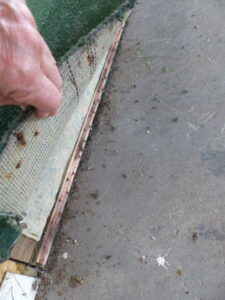Home Upkeep!
From time to time, we post a blog about home care on Winding Pathways. Ways to upgrade appliances and refinish the structure. Although removed from our normal nature tips, home care is both important and interesting. One TV ad caught our attention about a low-maintenance polyaspartic garage floor. We checked it out and decided to pursue it.
Our realtor friends tell us that investing 3% to 5% of a home’s value annually for maintenance, modernization, and freshening helps the structure keep its market value. It also makes the house pleasant, safe, and efficient.
This year our improvements included replacing a 26-year-old furnace and a nearly as old air conditioner. Both were working but their age indicated possible failure, and we didn’t want the furnace to conk out on a 20 below Iowa night.
New Polyaspartic Garage Floor
Our garage needed attention. We noticed staining on the baseboards and the floor was, well, shabby. Likely installed in 1947 when the house was built the floor was old, pitted concrete. It was dusty and hard to sweep. Come winter the car brings in salt brine picked up on roads. It penetrates into the old concrete and is nearly impossible to remove.
This summer we hired the Hello Garage Company to install a floor of Polyaspartic. Before the workers came, we promised to remove the baseboards so they could apply the surface right up to the wall. While pulling off the baseboards we found a distressing problem.
Years of seeping moisture had caused the bottom sill to rot. Nothing was holding up part of the wall. Fortunately, the rest of the wall was in good condition but the rotted area needed attention before the Polyaspartic could be applied. It became a DIY project.
Preparing for the New Garage Floor
- Removed baseboards and trimmed the wallboard higher to expose vertical 2X4s.
- Removed all rotted wood, which actually looked like topsoil.
- Cut off the rotted bottoms of the vertical 2X4s.
- Replaced the rotted sill with pressure-treated lumber, using shims beneath the verticals to give the wall solid strength.
- Screwed strips of ½” plywood onto the new sill to enable attaching the baseboard.
- Painted the baseboards but left them in storage for a while.
- Repainted the entire garage and installed sideboards to protect the walls from car doors banging against them.
- Washed shelves and containers before putting them back.
Hello Garage workers then ground down the old concrete floor, removing many of the potholes and unevenness. They then applied the Polyaspartic. We let it cure for more than two full days before bringing in the car or walking on it.
The final part of the job was screwing in the old refurbished baseboards and re-setting the garage with the cleaned-off shelves and containers. The garage looks great. Here are the before and after photos.
- Noting areas to repair.
- Repaired baseboard & wall protectors.
- Hello Garage crew ground the old flooring.
- Working back to front.
- Hello Garage crew Cleaning up excess
- Applying sealer.
- Curing
- Garage Floor & Equip Inside.









